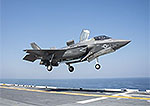Marines' deadly fighter jet to make its first ship-based deployment next year
 The concept was rolled out by Adm. Scott Swift during an April 26 all-hands call on the destroyer Momsen, which was docked in Hawaii on a port visit.
The concept was rolled out by Adm. Scott Swift during an April 26 all-hands call on the destroyer Momsen, which was docked in Hawaii on a port visit.
“I think this is going to revolutionize where we are with expeditionary strike groups,” Swift said. “The three-ship PAC SAG that [destroyers] Decatur, Momsen and Spruance are part of will pave the way for another SAG, just like this one, attached to the large-deck amphib so that it will become what I’m calling an ‘Up-Gunned ESG.’”
A typical ESG includes an amphibious assault ship, a dock landing ship or amphibious transport dock and a couple of destroyers or a cruiser and a destroyer. An attack sub may also accompany the group.
This new concept, with the addition of the joint strike fighter, looks a lot like a mini-carrier strike group. The surface action group envisioned by Swift would include a big deck and a handful of shooters.
Swift also said he has asked the destroyer squadron leader for the surface action group currently deployed to assign warfare commander responsibilities to the different ships and to act as if it were attached to the expeditionary strike group. The Decatur, which is a ballistic missile defense-capable ship, could take on the role of air warfare commander, a role typically assigned to a cruiser.
“I’m excited about the potential options you will explore as part of this three ship SAG,” Swift told sailors.
The SAG was deployed from Washington state and San Diego and was sent to be a test-case for new tactical concepts.
The idea is to break up groups of surface combatants to threaten enemy ships and land targets from multiple angles and force the adversary to devote surveillance assets like submarines and aircraft to find them. The surface action groups pull the enemy in multiple directions and make it harder to target carrier strike groups.
The up-gunned ESG takes that approach a step further and creates even more problems for an adversary when you add the F-35B, which has a significantly longer range than the AV-8B Harrier, which is a mainstay of the Marines' ground-attack mission. The F-35B will be able to take off vertically. It's the version that the Royal Navy plans to put on its new class of carriers, rather than the F-35C that features a tail hook.
An up-gunned ESG could also help alleviate some of burden on the overstretched flattop fleet, though the amphibious assault ships will only pack six to eight F-35s, said Jerry Hendrix, a retired naval aviator and analyst at the Center for a New American Security. That's compared to roughly 40 jets on an aircraft carrier.
“This is a step forward in the right direction,” Hendrix said. “What Adm. Swift is doing is tuning the force to get the most out of it, and that’s important given the carrier shortage we have right now. It also shows the scalability of the force to meet different demands.”
Seth Cropsey, head of the Hudson Institute’s Center for American Seapower, agreed it was a step in the right direction but that the concept was still large and expensive for low-to-mid-range missions.
“If we want ESGs to fight smaller brush fires to leave the carriers to larger conflagrations, that’s fine but it’s still expensive,” Cropsey said. “The F-35B is not something you buy in your local CVS.”
The Navy is still trying to find the right way to use its high-tech and expensive force that regularly gets called to do low-end missions such as counter-piracy and disaster relief, Cropsey said.
“They are still adjusting the dials and come up with something that handles both large-scale warfare — and in the Western Pacific that means China — and the lower order things like [humanitarian assistance, disaster relief]. I don’t think the up-gunned ESG is the end of the line, and I don’t think PACFLT thinks it’s the end of the line either.”